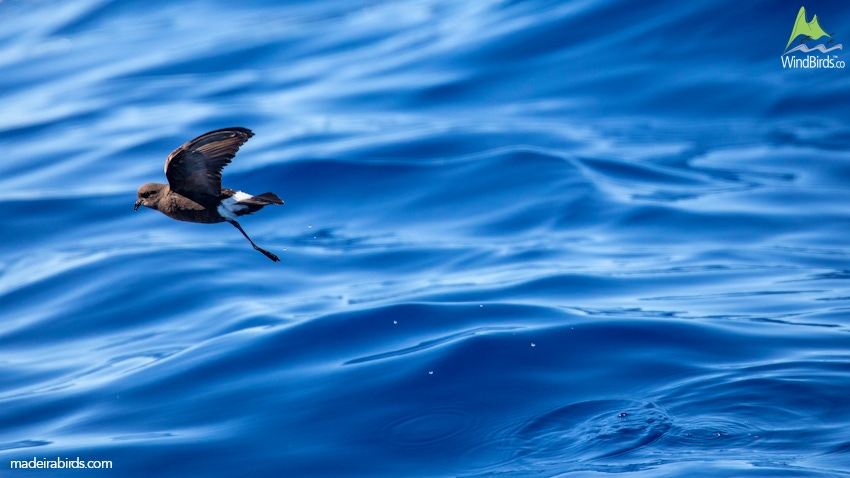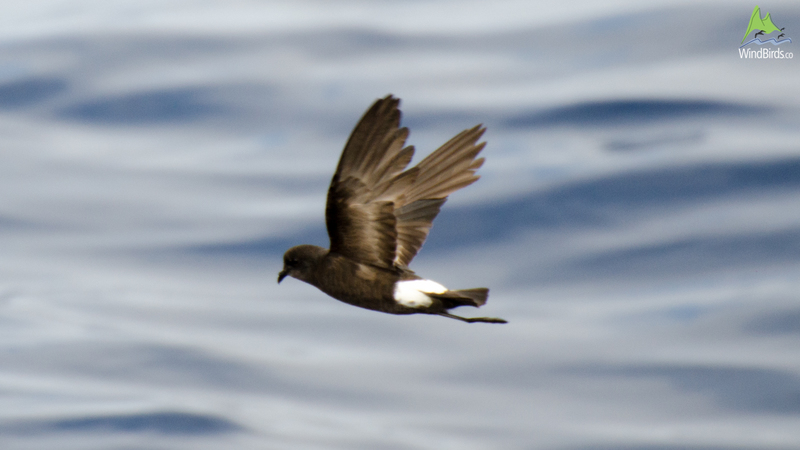Wilson's Storm-petrel Oceanites oceanicus (Kuhl, 1820)
Order: Procellariiformes Family: Hydrobatidae Status: Vagrant to Madeira

Recommended birdwatching sea trips to watch this seabird
Zino’s Petrel Pelagic Expedition

Wilson's Storm-petrel Field ID Keys
Shape & Size
Oceanites oceanicus is a small pelagic bird though a medium sized storm-petrel with long legs. It has a “relatively short arm, broad wings (...) and toes typically project noticeably beyond tail in flight” (Howell, 2012). Its tail is straight-ended even when fanned.
Colour Pattern
This is a black and white seabird with a pale grey upper wing bar, dark brownish-black underwings and a large white rump that extends to lateral under tail coverts.
It has yellow webbing between its toes, only visible at very close range
Behavior
In Madeira waters, it is usually seen alone. Flies like a swallow with “long soaring-flights interspersed with short series of wing-beats” (Duivendijk, 2010).
It is normally attracted to chum where it can spend some hours foot-pattering and dancing with the waves to collect food, resembling White-faced storm-petrel feeding behaviour.
Habitat
Wilson’s storm-petrel is a pelagic bird that breeds in the South Atlantic and visits all major oceans except the Arctic. Around Madeira Oceanites oceanicus is typically seen offshore.
Distinction from similar species
When compared to Hydrobates pelagicus, Oceanites oceanicus is bigger in size though it is smaller than Oceanodroma castro. The toes projected beyond the tail when flying is a good feature to distinguish from the other two species though sometimes it helds them drawn in.
Oceanites oceanicus Biometrics
Wingspan: 380 - 420 mm (Flood & Ashley, 2011)
Total length: 150 - 190 mm (Flood & Ashley, 2011)
Weight: 35 - 50 g (Flood & Ashley, 2011)
Other Bird Facts
Seasonality in Madeira: Seen from end of April to end of August
Breeding: From December to May in the South Atlantic
Diet: Its diet consists mainly on planktonic crustaceans, especially krill, and small fish
Status
Madeira local status by Correia-Fagundes et al, 2021: Seasonal
Madeira local status by Romano et al, 2010: Seasonal vagrant
Madeira local status by Zino et al, 1995: Exceptional vagrant
Conservation status by the IUCN Red List Categories, 2013: Least Concern ver 3.1
Name of this species in other languages
Portuguese: Painho de Wilson, Alma-de-mestre
German: Buntfuß-Sturmschwalbe
Dutch: Wilsons Stormvogeltje
Swedish: Havslöpare
Danish: Wilsons Stormsvale
Finish: Etelänkeiju
Norwegian: Wilsonstormsvale
Spanish: Paíño de Wilson
French: Océanite de Wilson
Italian: Uccello delle tempeste di Wilson
Polish: Oceannik żółtopłetwy
Slovak: Búrkozvest Pestronohý
Czech: Buřňáček Wilsonův